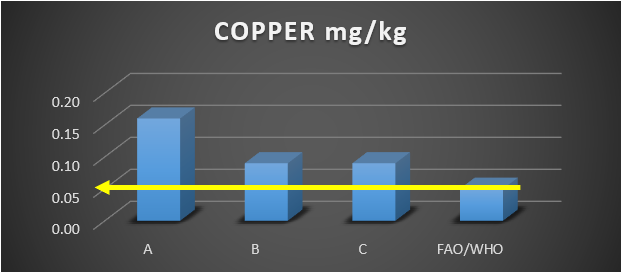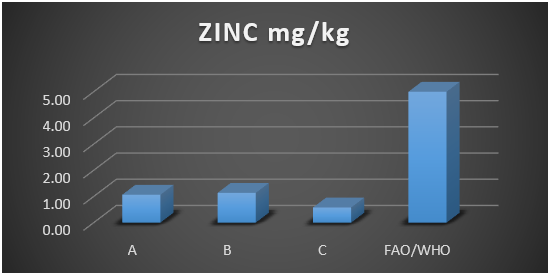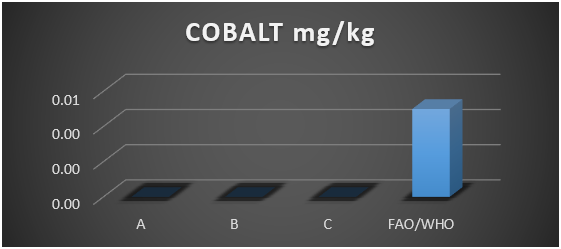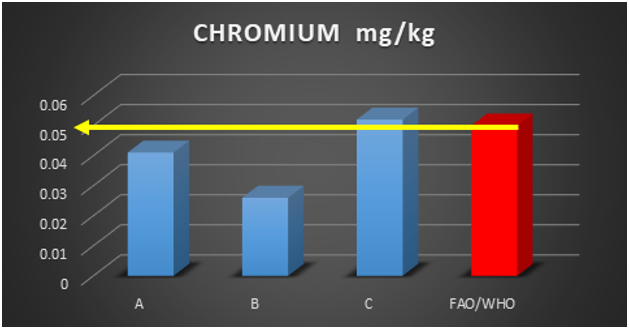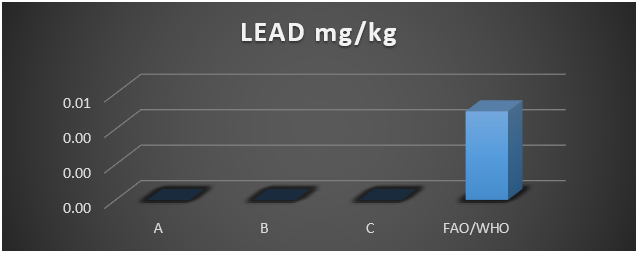Research Article
Volume 5 Issue 2 - 2023
Assessment of Heavy Metal Contamination in Three Most Prominent Commercial Floating Fish Feed Samples within Lagos Metropolis, South-West Nigeria
Nigerian Institute for Oceanography and Marine Research (N.I.O.M.R), P. M. B. 12729, 3-Wilmot Point Road, Victoria Island, Lagos, Nigeria
*Corresponding Author: Edah Bernard, Nigerian Institute for Oceanography and Marine Research (N.I.O.M.R), P. M. B. 12729, 3-Wilmot Point Road, Victoria Island, Lagos, Nigeria.
Received: April 05, 2023; Published: June 07, 2023
Abstract
This study focused on some heavy metal concentrations of some commercial fish feed within Lagos metropolis, South West Nigeria. We determined the concentrations of Copper (Cu), Zinc (Zn), Cobalt (Co), Chromium (Cr), Cadmium (Cd), Lead (Pb) and Nickel (Ni) in order to evaluate their possible risk of feed contamination. Co, Cd and Pb concentrations were found below detection limits. Zn concentrations for all samples were found within FAO/WHO acceptable limits. However, mean concentrations of Cu, Cr and Ni for all feed samples were found to be much higher than the maximum acceptable limits set by FAO/WHO which are 0.05 mg/kg, 0.06 mg/kg and 0.05 mg/kg respectively. This study thus reveal disturbing levels of heavy metals in some commercial fish feed within Lagos metropolis.
Keywords: Heavy metals; Fish feed; Lagos
Introduction
Over the years, cultured fish species have shown to require supplementary feed as the available natural food in confined culture systems are not adequate as in the natural water bodies. Hence, sufficient nutritional feed is important for fish cultured in captivity to enhance growth as well as increase immunity towards infections in other to achieve the desired harvest.
In Nigeria, feed production is expanding rapidly in-line with increasing growth in the fish industry. Fish feed accounts for over 70% of production cost. Nigeria imports over 40,000 tons of fish feed significantly for tilapia and catfish production valued at over $60 million annually. These imports are mostly from Israel (60%) and the EU (40%). All imported feeds are floating and come in 15 kg and 20 kg bags and in; 2, 3, 4, 5, 6, and 8 mm (Foraminifera market research, 2019). However, Recent studies have shown that, some commercially sold fish feed contain significant amount of contaminants including heavy metals like; lead, cadmium, chromium, mercury and arsenic, many of which are toxic at low concentrations and can bio-accumulate and bio-concentrate in fish and consequently in man (Sloth J.J., 2011).
Yahaya et al., 2016 stated that, eating of fish is a major avenue were man is exposed to pathogens and heavy metals. Studies by Akan et al., 2009 and Meijer et al., 2007 also revealed that any contamination of aqua-feed can greatly affect both the fish and their consumers.
Therefore, the objective of this study was to determine the concentration of Cadmium (Cd), Cobalt (Co), Chromium (Cr), Lead (Pb), Nickel (Ni), Copper (Cu) and Zinc (Zn) in three most prominent branded commercial fish feed sold within Lagos metropolis.
Materials and Method
Study area
This study was carried out in Lagos State, South-West Nigeria. Samples of fish feed were collected from Oko-Oba in Agege, Lagos State. Oku-Oba is famous for its abattoir market, livestock and aqua feed markets.
This study was carried out in Lagos State, South-West Nigeria. Samples of fish feed were collected from Oko-Oba in Agege, Lagos State. Oku-Oba is famous for its abattoir market, livestock and aqua feed markets.
Three different fish feed samples; (A), (B) and (C) were collected for this study. Samples (2.0 mm each) were collected in clean polyethylene bags from whole-sellers and transported to the analytical chemistry laboratory of the Nigerian Institute for Oceanography and Marine Research.
Determination of Heavy Metals
Both heavy metals and trace elements were assessed after digestion of samples. The metals analyzed are; Copper (Cu), Zinc (Zn), Cobalt (Co), Chromium (Cr), Cadmium (Cd), Lead (Pb) and Nickel (Ni) using an Atomic Absorption Spectrophotometer (AAS), model number ICE 3000 AA.
Both heavy metals and trace elements were assessed after digestion of samples. The metals analyzed are; Copper (Cu), Zinc (Zn), Cobalt (Co), Chromium (Cr), Cadmium (Cd), Lead (Pb) and Nickel (Ni) using an Atomic Absorption Spectrophotometer (AAS), model number ICE 3000 AA.
Statistical Analysis
Data obtained from this study were subjected to Analysis of Variance (ANOVA) and means were separated using the Duncan’s Multiple Range Test (Duncan, 1995) using the Statistical package for Social Science (SPSS), version 16, Chicago, Illinois, USA. Differences were considered significant at p< 0.05 (Zar, 1998).
Data obtained from this study were subjected to Analysis of Variance (ANOVA) and means were separated using the Duncan’s Multiple Range Test (Duncan, 1995) using the Statistical package for Social Science (SPSS), version 16, Chicago, Illinois, USA. Differences were considered significant at p< 0.05 (Zar, 1998).
Results and Discussion
The results from the analysis of heavy metals of three (3) branded fish feed samples within Lagos metropolis are presented in Table 1. Sample (A) had the highest mean Copper content (0.16 ± 0.04) while sample (C) had the lowest (0.07 ± 0.01). Zinc content was highest in sample (A) with a value of 1.067 ± 0.03 and lowest in sample (C) with a value of 0.33 ± 0.03. The mean highest concentration of Chromium and Nickel for all three samples A, B and C were; 0.041 ± 0.00, 0.026 ± 0.03, 0.052 ± 0.05 and 0.15 ± 0.00, 0.270 ± 0.02, 0.13 ± 0.02 respectively. However, no presence of Cobalt, Cadmium and Lead were detected in all three samples (Figures 3, 5 and 6).
| Metals | A | B | C |
| COPPER mg/kg | 0.16 ± 0.04c | 0.11 ± 0.00b | 0.07 ± 0.01a |
| ZINC mg/100g | 1.067 ± 0.03c | 0.61 ± 0.08b | 0.33 ± 0.03a |
| COBALT mg/kg | ND | ND | ND |
| CHROMIUM mg/kg | 0.041 ± 0.00b | 0.026 ± 0.03a | 0.052 ± 0.05c |
| CADMIUM mg/kg | ND | ND | ND |
| LEAD mg/kg | ND | ND | ND |
| NICKEL mg/kg | 0.15 ± 0.00a | 0.270 ± 0.02c | 0.13 ± 0.02c |
Means ± SD: Standard Deviation; Values in the same row and with the same superscript alphabet are not significantly different (p>0.05).
Table 1: Heavy metal concentration of three fish feed samples within Lagos Metropolis.
Table 1: Heavy metal concentration of three fish feed samples within Lagos Metropolis.
Copper (Cu) is an essential trace element which is important for normal biological activities of amino acids and is needed for some essential enzymes such as superoxide dismutase, cytochrome oxides, and lysyl oxides. However, studies have shown that Cu is highly toxic in aquatic environments and has effects on fish, invertebrates, and amphibians (Kamaruzzaman et al., 2010 and Mannan et al., 2018). In this study, the concentration of Cu recorded from the three prominent fish feed samples were all found to be above the FAO/WHO permissible limit of 0.05mg/kg. This high increase (Figure 1) may be due to ingredient contamination before and during feed processing. This finding is in line with the report of Yahaya et al., 2016 who worked on the heavy metal content of some compound fish feed in Northern Nigeria.
Zinc is one of the most important essential nutrients of great public health significance. It participates in several enzymatic activities which are of great importance for growth and development particularly in the metabolism of DNA and protein during cell differentiation and cell replication. The requirement of Zinc is greatest in fast growing animals, and the effects of Zinc deficiency are most harmful during embryonic development of young animals where cell differentiation and replication are highest (Chasapis et al., 2020). The concentration of zinc detected in this study are similar to the findings of Adeniji and Okedeyi, (2017) with values ranging from 1.7 mg/kg to 2.01 mg/kg. Edah et al., 2019, who worked on the heavy metal content of some fishmeal samples within Lagos metropolis also reported Zinc concentrations ranging from 1.02 ± 0.27 to 2.534 ± 0.36 mg/kg which is similar to the findings of this study.
Most aquatic fishes have a harder time breaking down soluble carbohydrates in their diet thus reducing their nutritional contribution in the diet of many aquatic species. Moderate dietary inclusion of Chromium has been linked to improving carbohydrate use in animals and is thought to be connected to insulin production. However, high concentrations of Chromium is known to be one of the most environmentally toxic pollutants. Disruption in sugar metabolism and severe heart conditions are sometimes related to high levels of chromium. Excess chromium also causes damage to kidney, liver and blood cells through oxidation reactions (Dayan and Paine, 2001). In this study, the levels of Chromium in fish feed samples are lower than the permissible limits set by FAO/WHO in animal feed except for sample (C) with a value exceeding the FAO/WHO permissible limit. This could also be due to ingredient contamination during feed processing and production. Values obtained are similar to the findings of Adeniji and Okedeyi (2017) who worked on the preliminary assessment of heavy metal concentrations in selected fish feed ingredients in Nigeria.
Nickel (Ni) are essential for normal physiological process. Aquatic eco-toxicity testing has shown that NiSO4. 6H2O and NiCl2.6H2O fall into the "harmful" classification where their abnormally high concentrations may become toxic and disrupt the homeostasis balance in the cells of an animal (Ololade and Oginni, 2010). Values of Nickel in this study were all above the FAO/WHO permissible limit of 0.05mg/kg. This high value may be due to either natural pollution including volcanic activities, weathering of bedrocks of the aquatic environment where fish is caught for fishmeal purposes which is an ingredient in fish feed or anthropogenic factors including mining activities, incineration of waste and agricultural use induced during the processing of ingredients for fish feed. The values obtained are similar to the reports of Ololade and Oginni, 2010 but dissimilar to the report of Anhwange, 2012 with concentrations of 0.2mg/kg and 0.92mg/kg respectively.
Conclusion
This research revealed high concentrations of copper, chromium and nickel in the three prominent commercial fish feed samples with concentrations much greater than the recommended FAO/WHO values. More attention by relevant stakeholders should be given to the sources vis à vis where these commercial feeds are sourced from, and also, the nutritional quality of commercial feeds used in farmed fish production. A comprehensive nutritional quality assessment of all commercial feed samples in Lagos metropolis is recommended. This is necessary to promote food safety.
References
- Adeniji, CA, Okedeyi OO. (2017). Preliminary Assessment of Heavy Metal Concentrations in Selected Fish Feed Ingredients in Nigeria. J Fisheries Livest Prod 5: 2332-2608.
- Akan, J.C, Abdulrahman F.I, Sodipo, O.A and Akandu, P.I. (2009). Bioaccumulation of some heavy metals of six death water fishes caught from lake Chad in Doron Buhari, Maiduguri, Boron State; Nigeria. Journal of applied science in environmental sanitation, 4: 103-114.
- Anhwange, B.A Asemave, K. Kim, B.C and Nyiaatagher D.T. (2012). Heavy Metals contents of some synthetic fish feeds found within Makurdi Metropolis. Internat J. Food Nutrition and safety. 2 (2): 55- 61.
- Adeyemi, Y. B.; Edah Bernard; Adetola. I. Oke. (2019). Heavy metal content of some fishmeal samples within Lagos Metropolis, Nigeria. 53rd Annual Conference Proceedings of the Agricultural Society of Nigeria (ASN).
- Chasapis, C.T., Ntoupa, PS.A., Spiliopoulou, C.A. et al. (2020). Recent aspects of the effects of zinc on human health. Arch Toxicol 94, 1443–1460 (2020).
- Foraminifera market research. (2019).
- Kamruzzaman, B.Y; Ong, M.C; Rina, S.Z and Joseph, B. (2010). Levels of some heavy metals in fishes from Pahang river estuary, Pahang, Malaysia. J. Biol Sci. 10: 157-161.
- Mannan MA, Hossain MS, SakerMAA, Hossain MM, Chandra L, Hamidal Haque ABM and E-zaham Mk (2018) Bioaccumulation of Toxic Heavy metals in fish after feeding with synthetic feet. A Potential Health Risk in Bangladesh. Journal of Nutrition and Food Science 8: 728.
- Meijer, A.G, Akan J.C. (2007). The risk of contamination of food with toxic substances present in animal feed. Animal feed science and technology 2007. 133: 84-108.
- Ololade IA, Oginni O. (2010). Toxic stress and hematological effects of nickel on African catfish, Clarias garriepinus, fingerlings. J. Environ. Chem. Ecotoxiccol. 22: 14-19.
- Paul Y. Idakwo., Charles A. Negbenebor., Mamudu H. Badau., David I. Gbenyi. (2016). Total volatile base nitrogen (TVBN) and trimethylamine (TMA) content of “Bunyi youri” as influenced by the addition of glucose and clove during storage. International Journal of Biotechnology and Food Science Vol. 4(5): 81-85.
- Sloth, J. J. (Invited author). (2011). Heavy metals in feed - Current regulation, risk assessment, methods of analysis, examples and future trends. Sound.
- Zar, J.H., (1996). Biostatistical analysis. Third edition, Prentice-Hall Inc., New Jersey, USA.
Citation: Edah Bernard and Oke Adetola. I. (2023). Assessment of Heavy Metal Contamination in Three Most Prominent Commercial Floating Fish Feed Samples within Lagos Metropolis, South-West Nigeria. Journal of Agriculture and Aquaculture 5(2).
Copyright: © 2023 Edah Bernard. This is an open-access article distributed under the terms of the Creative Commons Attribution License, which permits unrestricted use, distribution, and reproduction in any medium, provided the original author and source are credited.

